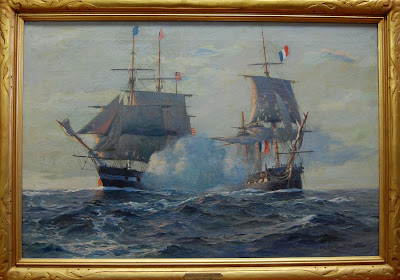Artifact Spotlight: Naval Aviator's Uniform, 1918
---Patricia McNamee, Curatorial Volunteer
As we are nearing the end of the centennial of naval aviation, it is an ideal time to focus on an artifact in the museum collection connected to the early years of aviation in the U.S. Navy. During the First World War (1914-1918), naval aviation was still in its infancy. On April 6, 1917 when the United States declared war on Germany, only 48 aviators and 54 aircraft were available. By war’s end, the Navy expanded with 2,000 planes flying out of 27 bases in Europe. The first official uniform for aviation, closely related to the U.S. Marine Corps summer uniform, was authorized on June 22, 1917.
The following year, the aviator's summer service uniform changed from khaki to the forest green color seen here. The upper pockets of the tunic-style coat were pleated and two lower pockets were added. This particular coat bears the bullion aviator's wings and a victory medal ribbon bar on the left breast. Though by the end of 1918 aviators were authorized to wear leather puttees over the lower legs, this uniform has the earlier olive-drab wool wrap leggings of 1917. The breeches were adopted early on for greater comfort.
The uniform was stored in a service trunk that belonged to Albert Haywood, Jr. (Aviator No. 2185). The trunk, donated by Haywood's son-in-law, contained several uniforms, personal items, and a piece of airplane canvas signed by other aviators. Born in Flushing, NY, Haywood was commissioned as an ensign in the United States Navy during the war and was relocated to Pensacola, Florida for flight training. Most of the uniform is believed to be Haywood’s except the tunic which belonged to another member of his squadron, Ensign Roy E. Davis.
The uniform will be on exhibit in November.
Gift of Dean Jacoby 2010.03
Images courtesy of the Naval War College Museum
As we are nearing the end of the centennial of naval aviation, it is an ideal time to focus on an artifact in the museum collection connected to the early years of aviation in the U.S. Navy. During the First World War (1914-1918), naval aviation was still in its infancy. On April 6, 1917 when the United States declared war on Germany, only 48 aviators and 54 aircraft were available. By war’s end, the Navy expanded with 2,000 planes flying out of 27 bases in Europe. The first official uniform for aviation, closely related to the U.S. Marine Corps summer uniform, was authorized on June 22, 1917.
The following year, the aviator's summer service uniform changed from khaki to the forest green color seen here. The upper pockets of the tunic-style coat were pleated and two lower pockets were added. This particular coat bears the bullion aviator's wings and a victory medal ribbon bar on the left breast. Though by the end of 1918 aviators were authorized to wear leather puttees over the lower legs, this uniform has the earlier olive-drab wool wrap leggings of 1917. The breeches were adopted early on for greater comfort.
 |
| Haywood is sitting in a Curtiss F-Boat, at Pensacola Naval Air Station. |
The uniform will be on exhibit in November.
Gift of Dean Jacoby 2010.03
Images courtesy of the Naval War College Museum



Comments
Post a Comment